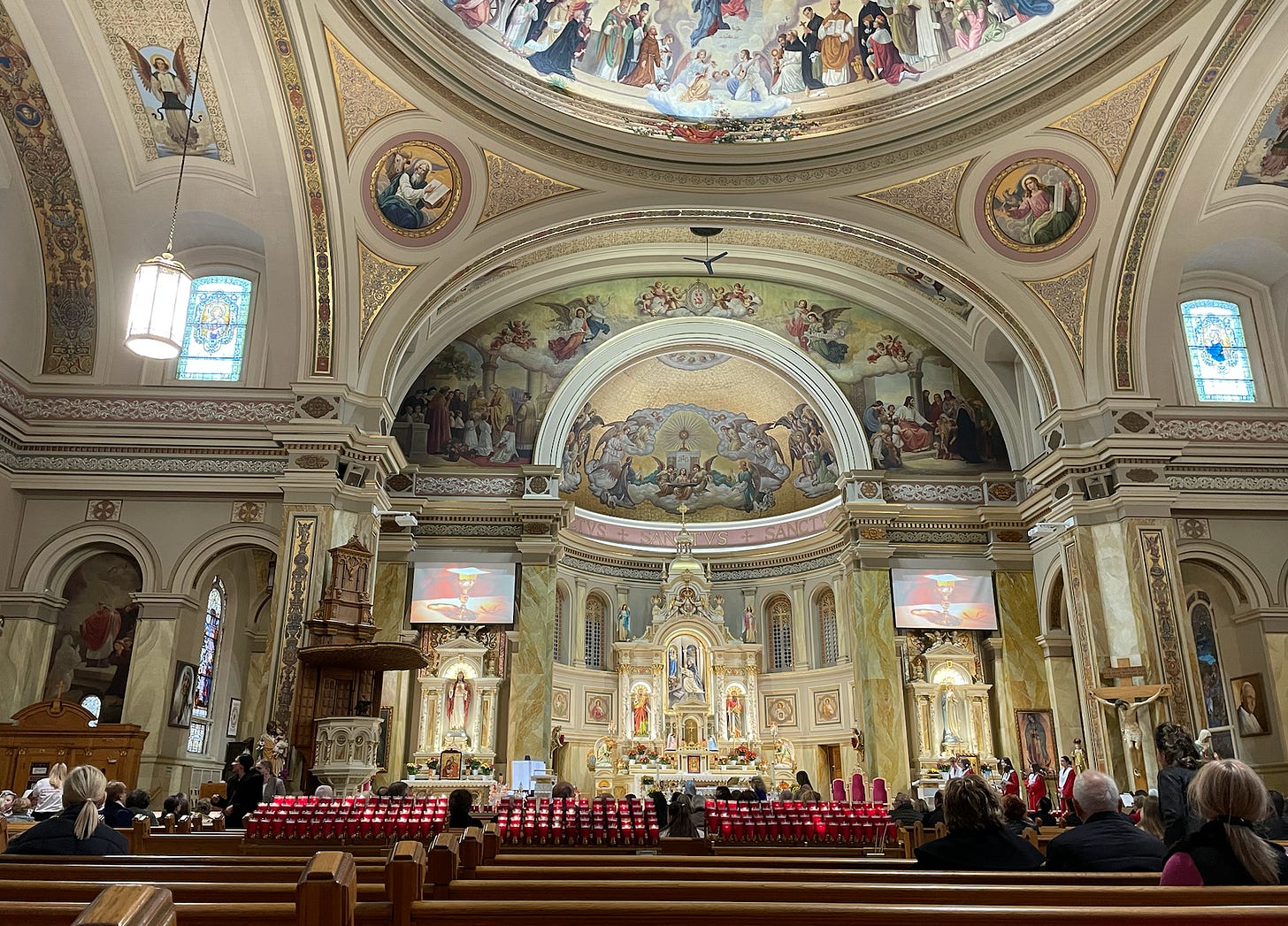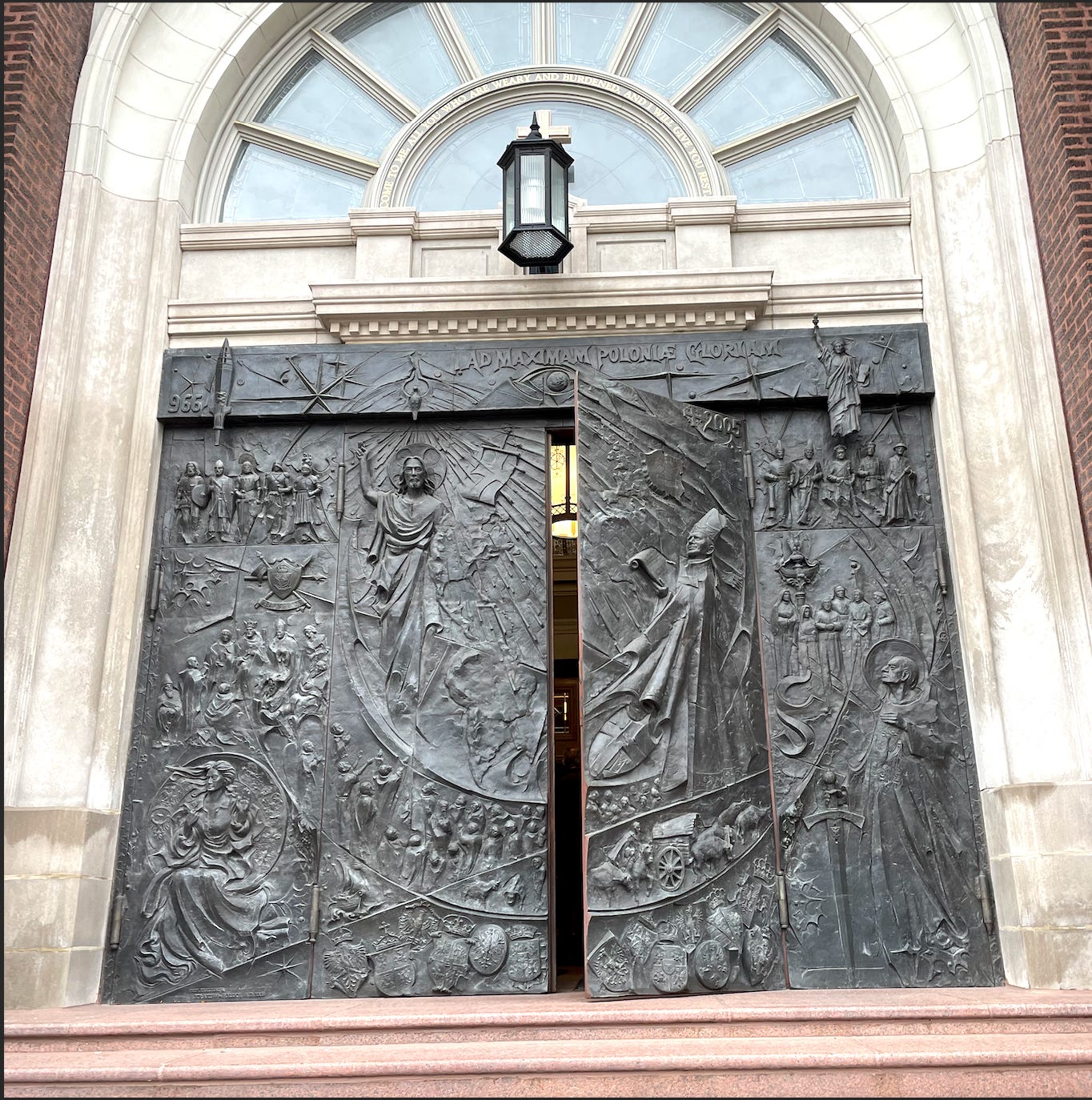After the service at this church, which was given entirely in Polish, I walked around the sanctuary a bit to check out the cabinet of relics, the pietà, and the prayer candles. And tucked away in a pew near the back was a small old woman who literally looked like she was from the old country. She wore a long lace veil on her head and looked up at me with the saddest, worn-out face. I imagine life hasn’t been easy but that this church, in her native tongue, must offer some comfort I cannot imagine.
The number of Polish immigrants moving to Chicago was rapidly increasing in the 1890s, and the population was quickly outgrowing the first Polish parish in the city: St. Stanislaus Kostka (which you can read about HERE).
Forty Polish families who had settled further north in an area called Avondale met in 1894 with the priest of St. Stanislaus Kostka, who had ridden his horse to meet them, to discuss starting a new church. Although the priest liked the idea, for St. Stanislaus Kostka was unable to accommodate the growing number of Polish attendees, he explained that the economy and a lack of money meant they might need to wait.
But those in Avondale didn’t want to wait and threatened to start an Independent national church on land they said that they recently purchased. So the priest quickly offered church land in the area, and a two-story wooden church was built there.
By 1906, the congregation consisted of nearly a thousand families, and before the end of the year, a new brick building was constructed with the understanding that a larger one would probably be needed soon. And they were right. By 1912, over 1700 families belonged to the church. Initially, the archdiocese started a new church nearby, St. Wenceslaus, to ease the crowding at St. Hyacinth.
Even so, the church continued to grow and in 1917 construction began on the church where parishioners meet today. It was completed in 1921.
As for the namesake of the church, St. Hyacinth, he was born in 1185 in what is today Poland. He was a Dominican priest and an educator. He was known for spreading Christianity in Poland and in the regions around it. In addition to being the patron saint of Poland, he is also the patron saint of those in danger of drowning and weight lifters. This is thanks to a story he is most well-known for: he saved a crucifix and statue of Mary during an attack on a monastery. He carried both, which weighed more than he could have possibly carried, over a river to safety, and as a result, he is often depicted carrying these two items.
Finally, the church was designated a basilica, one of only three in Chicago, in 2003 by Pope John Paul II. This designation is given to churches with a unique historical, artistic or religious importance.
Believe it or not, this church still holds multiple services in Polish each week. So I attended a Sunday Polish mass. The sculpted bronze doors to the church are enormous. The three sets were installed fairly recently, in 2005. The center doors depict the history of the church, with the main figure as St. Hyacinth.
Inside, the church is enormous. And cavernous. Plus, the service was very crowded, with hundreds attending. What appeared to be a youth choir was singing in the front, all in red robes, when I walked in. And hundreds of red prayer candles lined the front of the church by the altar and the middle aisle that ran parallel to the altar, the flames flickering in a bright dance.
The procession began on the front left side. In walked eleven altar boys in white robes (ranging in age from about eight to adult) and two priests in green robes. The oldest altar servers came first. The first one carried the thurible (the metal container on chains that holds the incense), the second had an object in his hand that I couldn’t identify (possibly a “boat” that holds the incense), and the third carried the cross. The first two held one hand over their heart. The fourth and fifth altar boys carried long candle sticks, and the remaining held nothing. But the two carrying the candles and the one following them all wore green amices (a rectangular cloth around the neck and shoulders).
Following them were a dozen or so young children, accompanied by a couple of nuns and a few other adults, who were dressed up as angels, complete with wings and halos.
This is probably the largest procession I’ve seen in a Catholic Church. They all walked up the side aisle to the middle aisle that crosses the church, and then down the center aisle to the altar.
While they came in, the choir, accompanied by the organ, sang a song in Polish to the tune of “When the Saints Go Marching In.”
I guess now is as good a time as any to mention that I attended a service in Polish. I knew I would not understand anything, but I was really curious to see how well it was attended and to witness it in the language it had been preached here for over a hundred years. Of course, as I don’t speak Polish, that fact will severely limit my comments here!
The service followed the expected Catholic mass structure. And there were screens with words to prayers and songs projected, something I usually see in more evangelical churches and not usually in Catholic ones. But these were actually very non-intrusive. So often the screen becomes the most dominant thing in the church, centered on the altar. These screens were high up on either side of the altar. When the words were not displayed, a photo of a communion cup was projected, but the colors of the cup and the background blended into the wall behind them, making the screens difficult to even notice during most of the service.
When the priest did the Gospel reading, the two altar boys with candles stood on each side of him, and the two adult servers stood behind him. The reading came from Mark 12:28b-34. In English it says,
28 One of the teachers of the law came and heard them debating. Noticing that Jesus had given them a good answer, he asked him, “Of all the commandments, which is the most important?”
29 “The most important one,” answered Jesus, “is this: ‘Hear, O Israel: The Lord our God, the Lord is one.[a] 30 Love the Lord your God with all your heart and with all your soul and with all your mind and with all your strength.’[b]31 The second is this: ‘Love your neighbor as yourself.’[c] There is no commandment greater than these.”
32 “Well said, teacher,” the man replied. “You are right in saying that God is one and there is no other but him. 33 To love him with all your heart, with all your understanding and with all your strength, and to love your neighbor as yourself is more important than all burnt offerings and sacrifices.”
34 When Jesus saw that he had answered wisely, he said to him, “You are not far from the kingdom of God.” And from then on no one dared ask him any more questions.
During the sermon, in Polish, I found myself looking around at the incredibly ornate sanctuary. The crucifix stood majestically on a large column to the right near the front of the church. I suddenly realized that this is the location I have seen in many churches while others place it at the back of the altar. I wondered about that, but I cannot seem to find any significance to the placement.
The priests and altar servers prepared for communion, and two of the little angels and four teenagers walked down the center aisle for the presentation of the gifts. I’ve mentioned a couple of times the middle aisle that crosses the church horizontally. Strangely, virtually no one in the pews behind that aisle (including me) went forward to receive communion. Yet everyone around me was fully participating in the service - crossing themselves, reciting the prayers, kneeling, etc.
Before the benediction and the procession out, the little children who were dressed up joined the small youth choir. They all sang a song, complete with movements, as the procession made its way back out the way they had come in.
One final note on this church. I picked up a program, and in addition to all the ads for life insurance, a Catholic dating site, and home security was a full page about the presidential election asking people to “weigh your conscience before casting your ballot.” Here is what the church had to say:
If you enjoyed this post, you can support my writing by leaving a tip or a custom donation. Just click on the button below. Thanks for your support!







